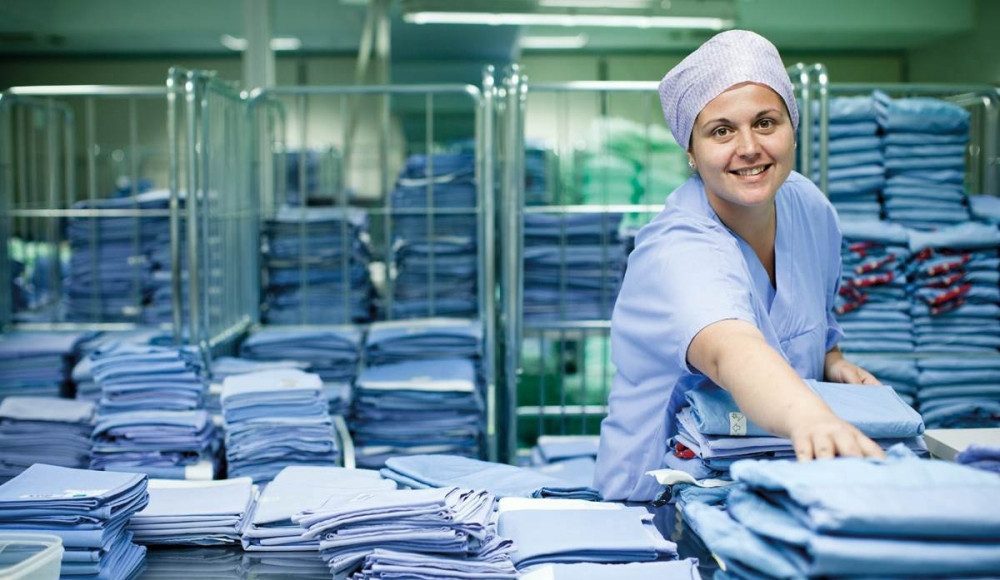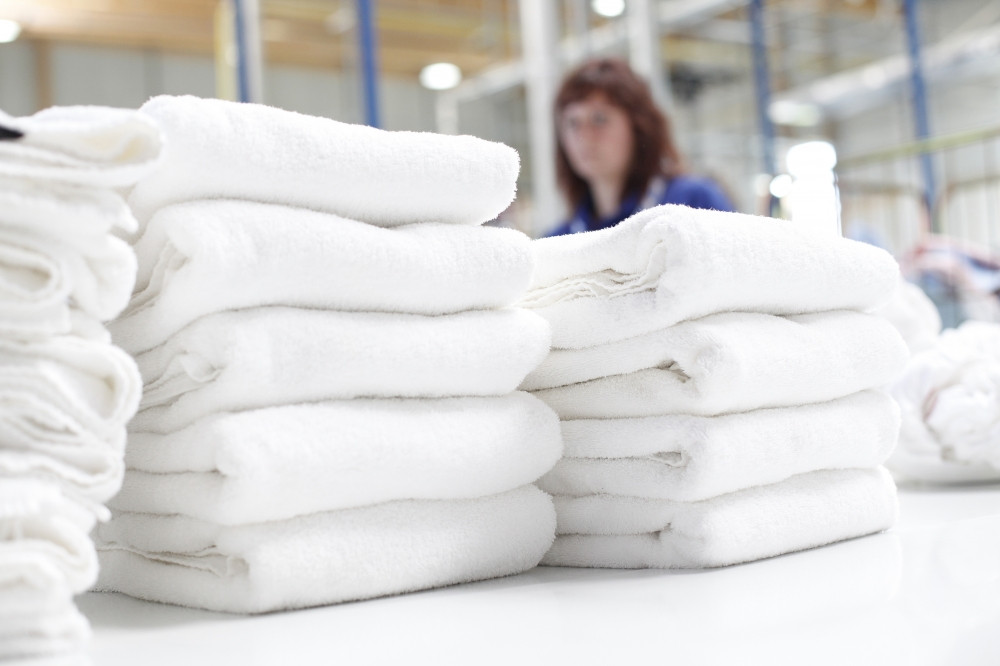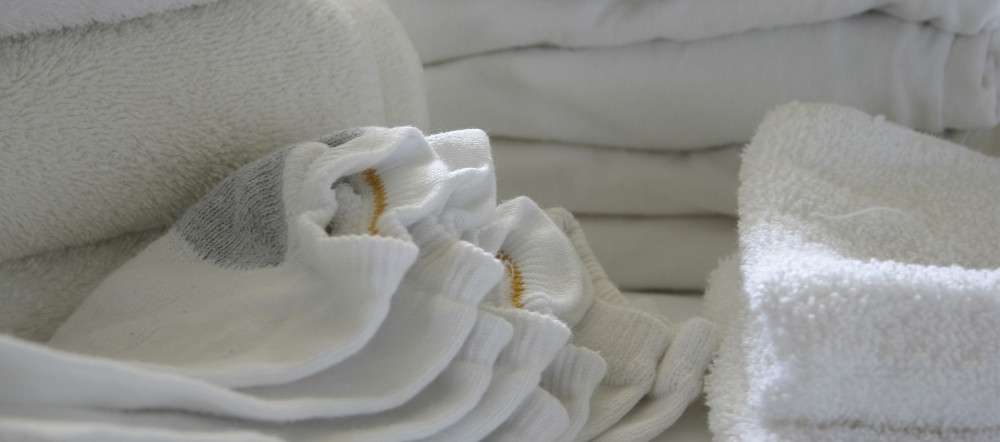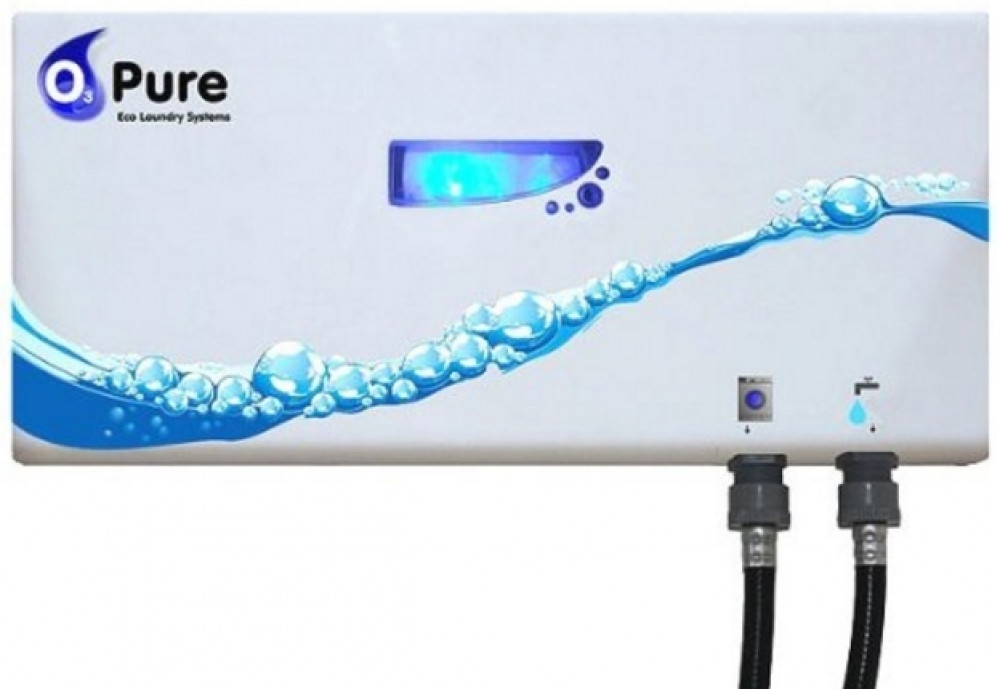
You might not think of architects as being particularly interested in laundry as a design issue, but we get really excited about saving our clients money and easing the impact that the facilities we create have on the environment. And when we're talking about thousands of tons of laundry being processed annually, the stakes are large... very large. We can cut hot water usage by 90% or more and dryer energy usage in half.
"We are saving one client over $145,000 a year by designing a 'green' laundry facility for them.
Being environmentally responsible is good business, on all levels." ~ Sam Rodell
Laundry, Water, and Carbon
Laundry operations are a substantial contributor to greenhouse gas emissions in developed countries. For every ton of linens, traditional institutional laundering methods consume, on average, 6000 gallons of water and burn through 7 million BTUs. A thousand room luxury hotel can create fifteen tons of laundry every day. Just in Las Vegas, there are more than 150,000 hotel rooms. Natural gas releases 117 pounds of carbon per million BTUs of heat created, so each ton of linen processed will push approximately 820 pounds of carbon into the atmosphere. So every day, well over a million pounds of carbon are added into the atmosphere by Las Vegas hotel laundries alone. Reductions in greenhouse gas emissions and tremendous savings in energy bills may be achieved by modernizing laundry practices, switching from chemical-intensive hot water washing to cold water ozone washing. The potential benefits are huge, environmentally and economically, and the outcome with respect to the quality of the finished laundry is superior.
Commercial Laundry and Linens
Typical commercial laundries at hotels, hospitals, universities, and sports or athletic facilities have as many as 12 steps in their typical workflow, using a large volume of water, energy, chemicals and time to get the linen clean. This is wasteful and unnecessary. The cost to maintain the water temperature alone (typically 140 to 160 degrees Fahrenheit) is causing facilities to look at new technologies to help them save money.
An ozone laundry system will greatly reduce the water, energy, chemicals, time and labor required to deliver a superior finished product, cleaning the laundry without hot water. Washing with ozonated water reduces operating costs, such as utilities and chemicals, increases productivity through shortened cycle times, and extends the life of washed fabrics.
A 1,000 room hotel with traditional laundering methods will use close to 100,000 gallons of water per day. For comparison, an 18-wheeler tanker truck on the highway holds a maximum of 9,000 gallons of liquid... so that hotel will use enough water to fill more than 9 of these 18-wheelers each day just doing laundry. Switching to ozone would reduce that water consumption by a minimum of 30% over traditional methods. That's enough water saved every day to fill up a typical residential swimming pool. These big water savings will also earn points toward US Green Building Council LEED certification.

3,000 Times Faster than Chlorine at Killing Bacteria and Viruses
Ozone reacts 3,000 times faster than Chlorine when oxidizing a contaminant. Ozone is highly effective at killing bacteria and viruses and at cleaning materials and surfaces without the need for Chlorine bleach. Ozone will create the same powerful cleaning agents without adding alkali. When alkali is eliminated, acid is no longer needed to buffer the pH of the wastewater. Elimination of these chemicals saves money, improves safety, and improves the appearance of linens by eliminating chemical residues. This can be accomplished without modifying washing equipment or changing the basic operating principles of laundry workflows.
Save Money by Lowering Energy Consumption
Money saved by reducing energy consumption is the biggest benefit of using ozone laundry because no hot water is needed and drying times are significantly reduced. Traditional washing methods require hot water to activate chemicals, but ozone does a better job in cold water, so the boiler for the washers can be eliminated. No boiler also means no gas to run the boiler and no maintenance costs. By eliminating most of the chemicals, there is no chemical residual to retain water. This means the washer extract cycle will remove more water so drying times will be significantly reduced, saving even more energy.

Increase Productivity by Reducing Wash Times
An ozone wash system will make it possible to expand washing capacity, reduce labor costs, or both. It's possible to increase laundry throughput using existing equipment by adding an ozone wash system instead of investing in more washing machines. Wash times with ozone are as much as 40% shorter. This is achieved by eliminating program fill/drain steps where chemicals are added and then rinsed out. Ozone replaces the chemicals and it is no longer necessary to use long formulas to get superior results. The typical ozone wash formula is from 20 to 40 minutes shorter than a traditional wash formula, so it is possible to wash more loads per day with the same equipment.
Reduce Dependence on Hazardous Chemicals
Ozone eliminates the need for almost all chemicals in the wash, except for a small amount of detergent. This is a fundamental paradigm shift from traditional laundering methods. Eliminating the chemicals also eliminates what is causing your linen to need a fabric softener. The linen comes out very white, soft and fresh-smelling. On average, detergent use reduced by half or more, creating additional savings.

Eliminate Hot Water Use For Laundry
Proper use of ozone to wash linens requires that you completely eliminate hot water in wash cycles where ozone is used. Ozone is a gas and it must be dissolved into water at high enough concentrations to be an effective cleaning agent for linens. For ozone to be dissolved into water efficiently and effectively, a sophisticated set of requirements must be met including eliminating heat. It is a natural physical property of ozone to require low temperatures to be dissolved effectively into water. The colder the water, the more efficiently ozone can be dissolved into it.
Shorter Wash Cycles
Eliminating some of the steps in a wash program eliminates the time required to complete those steps. Ozone laundry systems shorten wash programs by a minimum of 30%, and up to 50%, which accelerates production by the same amount. This translates into a sizable water and labor savings. Labor is arguably the most expensive component of any operation including commercial laundry. Many advances have been made over the years in automation technology to speed up a laundry's production rate and reduce the amount of labor required. Ozone laundry wash cycles are measurably shorter than traditional wash cycles due to the fact that some of the steps in the wash process have been eliminated. This reduction in wash cycle times accelerates the work flow and production rate which translates to a savings on labor.
Shorter Drying Times
Ozone laundry boosts extract efficiency and lowers water retention in the linen. Less water in the linens going to the dryers means it takes less time to dry them. This adds up to a huge savings in labor and energy. Water hardness is most often caused by Calcium and Magnesium being dissolved in the water. These dissolved minerals along with chlorine and other chemicals present in tap water and chemicals used on linens to increase their sheen and to repel soil all cause fabrics to be hydrophobic (they repel water). Chemical companies have developed detergents using powerful wetting agents that work well in water having these natural disadvantages. These chemicals cause fabric to act like a water magnet. Although these chemicals have worked well to improve the quality of textile care, they cause more water to be retained in the linen after extraction. More water in the linen means more time and energy are required to dry them.
Dissolved ozone in the wash will eliminate the need for wetting agents and greatly reduce the amount of chemicals you must use. Dissolved ozone acts like a water softener because it breaks surface tension on water. This neutralizes the tendency for water to bead instead of penetrating cloth. This softening effect boosts chemical performance and reduces chemical demand. Ozone also oxidizes or hydrolyzes Calcium and Magnesium which greatly reduces their hardening effect on the water. This greatly boosts chemical performance and reduces chemical demand. This also reduces the accumulation of minerals in linen which causes them to look dull and dingy over time. Ozone also neutralizes the Chlorine found in tap water and its water-hardening effects. This also boosts chemical performance and reduces chemical demand. Fewer chemicals, softer water and no wetting agents mean better rinsing and more efficient extraction. More efficient extraction means less water remaining in the linens. All together this means measurably shorter drying times and savings on labor and energy.
Extend the Life of Linens
Reap huge savings by at least doubling the life of linens. An ozone laundry system will greatly extend the life of your valuable linens by eliminating the harsh chemical treatments found in traditional wash chemistry. Ozone very effectively oxidizes soil, oils & greases, bacteria, viruses and other contaminants in your linens without the need to subject them to the typical mixture of chemicals in the washer. A pH of 11+ is enough to cause permanent injury to your eyes, skin, hair, etc. so you can imagine what it is doing to your fabric. Huge swings in pH cause untold wear and tear on your expensive linens. Very high pH causes fibers to swell unnaturally which leads to cracks in the fibers themselves. These cracked fibers shatter and are carried away by your dryer. Your expensive linens are being reduced to fuzz every time you wash them.
With ozone, laundry pH stays near neutral. By eliminating all of the harsh chemicals in the wash, you eliminate the harsh residue in the finished product. In laundry, you never actually get everything out in the rinse. A rinse simply serves to dilute the contaminants. When you add a lot of alkali and then acid to neutralize it, that doesn't mean it just disappears, actually it creates a mineral salt that remains in the fabric. The rinse cycle only reduces the concentration of this residue, it does not eliminate it. These residual salts are made up of crystals deposited in the fabric and their sharp edges accelerate the destruction of your valuable fabrics during the drying process. This mineral salt also remains in the towels and sheets after drying and ends up on your body when you use them. Most of us don't stay in bed long enough for the mineral salts to cause any real damage to our skin but bed-ridden patients in nursing homes and hospitals are subject to skin eruptions, boils and other skin ailments that lead to bed sores and have a negative impact on their overall health. Ozone laundry systems eliminate the chemical residues in the finished product because they eliminate the chemicals altogether. Upon converting to an ozone laundry standard, the appearance of your linen will improve each time it makes a journey through the new washing process.
Safer, More Sterile Linens
The use of ozone will assure the elimination of biological pathogens and countless other chemical contaminants from laundry. Ozone and its related companions are at the top of the list of most powerful oxidizers. Organisms have no chance of ever developing a resistance to destruction by ozone. Ozone blasts a hole in the cell wall or other containment mechanism of a pathogen and destroys it instantly. Older methods of sanitation using less effective sanitizing agents paved the way for the development of hard-to-kill microbes like MRSA/drug-resistant staph and other hospital-acquired infections. Chemical disinfection agents must first be absorbed by a pathogen to kill it so incomplete sterilization is expected. The bacteria that do survive and their offspring tend to become more resistant.

Green Chemicals
Ozone is truly a green laundry chemical. Ozone is a clean gas made entirely of pure oxygen which is available all around us. There is no need to store hazardous chemicals on site. Reservoirs of chlorine, alkali and acid are no longer needed. The detergent should be a biodegradable surfactant that will easily break down in the environment.
High concentrations of dissolved ozone will lead to the creation of hydroxyl radicals or OH molecules at a pH as low as 8 instead of the astronomically high 11 normally seen in traditional laundering methods. An OH radical is #2 on the scale of most powerful oxidizers in the Universe. The only compound more powerful is Fluorine gas, which is highly toxic. Therefore, hydroxyl radicals are the safest and most effective things to use at removing stains and odors and for killing bacteria and viruses.
Ozone is a triple oxygen (O3) molecule and is highly reactive on its own. As ozone breaks down, it releases a single oxygen atom, molecular oxygen (O1) and diatomic oxygen (O2). These single oxygen atoms instantly bond with the first thing they come into contact with, so they instantly neutralize stains, odors and biological contaminants. These free oxygen atoms also bond with hydrogen ions and form hydroxyl free radicals (OH). When ozone is applied in the proper concentration, a combination of powerful and environmentally friendly agents work together to clean the linens.
Chlorine bleach oxidizes carbon molecules much more slowly and not as completely as hydroxyl radicals and ozone. In the process it also creates a dizzying array of toxic chemicals called disinfection by-products (DBPs) including formaldehyde and chloroform. These DBPs are part of a family of nasty chemicals called THMs or trihalomethanes (halogenated compounds). There is no question that these compounds are carcinogenic. These compounds are also classified as VOCs or Volatile Organic Compounds. These VOCs pollute the air in and around the facility. Chlorine is also the single most damaging element to the earth's ozone layer and our use of it should be curtailed wherever possible.
The old staple, chlorine, is located at #16 down the list of most powerful oxidizers and that's what we've always depended on to get our whites white and our germs killed. The reason people haven't used ozone much before is because it is harder to use than chlorine. You just pour some chlorine in very hot water and that's it. With today's technology, however, ozone is finally the perfect solution for commercial laundry systems.
An ozone laundry system will reduce total chemical costs by 50% or more and eliminate most or all of the alkali, use a fraction of the detergent, and do away with chlorine and acid all together. The acid can be eliminated because you have eliminated the alkali. Normally after the pH has been elevated above 11 with plenty of alkali, acid is needed to bring the pH back down to a more hospitable level acceptable to the public sewer utility. This process is similar to adding acid to a swimming pool to bring the pH down. If laundry plant operators do happen to send these 'spikes' of caustic water down the sewer, certain impact fees or fines could be levied against their laundry. Wastewater from a laundry with an ozone laundry system will never incur any impact fees.

Green Wastewater
A typical laundry produces wastewater that is high in BOD (biological oxygen demand - food for bacteria) high in COD (chemical oxygen demand) and low in DO (dissolved oxygen). This is to be expected with the nature of the soil and chemical contaminants found on dirty linen. The soil consists of body oils and other secretions, food and other organic waste, organic stains like blood and grass stains, etc. Chemicals found in industrial laundry wastewater include the strong alkali, hefty amounts of chlorine bleach, lots of detergent, acid, fragrances, softeners, and more. The high BOD, COD and low DO are all counter-productive to the goals of the local wastewater treatment plant, which is trying to lower the BOD and COD and raise the DO so when they discharge the water, it won't damage the receiving stream's water habitat. The negative factors of a laundry's wastewater (BOD and COD) support the growth of algae in rivers which consumes all of the dissolved oxygen (DO) and thereby suffocates fish. So, laundries must go to expensive measures to 'buffer' their wastewater and reduce its negative aspects before releasing it to the sewer. If they don't, in some cases the laundry owner can be charged additional fees by the sewer provider or fined for unacceptable wastewater discharge. Some companies pay a lot of money in fines or impact fees because of their poor quality wastewater.
With an ozone laundry system, the ozone replaces most of the chemicals. Ozone, being made purely of oxygen, first oxidizes and destroys odors, stains, bacteria, viruses, parasites, cysts, oils and greases and reduces them to carbon dioxide gas, nitrogen gas, inert material and water. All organic substances are made of long-chain carbon molecules. Stains, odors, living organisms, oils etc. are all made of these molecules. Water with high concentrations of dissolved ozone is full of hydroxyl radicals. On contact, these powerful molecules instantly attach to the carbon in living bacteria and viruses, degrading the cell walls of bacteria and viruses and instantly killing them.
These hydroxyl radicals are OH molecules that deliver oxygen to the components in the water that are responsible for the BOD (biological oxygen demand). This neutralizes them and renders them harmless to aquatic life. Also, any remaining ozone, oxygen or OH molecules simply raise the DO (dissolved oxygen) content in the water. That's a win-win-win situation, superlatively green in nature (adding oxygen to the environment instead of toxic chemicals). With the elimination of BOD & COD and elevated DO, laundry wastewater will actually benefit the processes at the wastewater treatment plant.
Green Air
Eliminating chlorine and other harmful chemicals and reducing the amount of detergent used to process your linens will improve the air quality in and around the laundry facility. Eliminating the use of chlorine means the elimination of associated VOCs. No more acid and greatly reduced alkali means linens will last much longer and not shed as much lint in the dryers. This will greatly reduce the amount of airborne particles coming from dryer vents which will reduce the volume of particulates in the air.
Safe for Organic Linens
Keep 'Organic Linens' organic. Traditional laundering methods used on certified organic linens will render them un-certifiable. The chemicals used in traditional laundry chemistry will leave inorganic residues in the fabrics and will cause organic linens to no longer be considered organic. An ozone laundry system will assure that organic linens remain organic and healthful with no chemical residues.


Residential Ozone Laundry
A quick search on a site like Amazon.com will show numerous residential ozone laundry systems available. These work by adding a tiny bit of dissolved ozone to the cold water going into the washing machine. According to our laundry consultant, "...the mistake they make is telling people they can wash with no chemicals or soap at all. You will always need some soap to remove the dirt and get it down the drain. Soap encapsulates the dirt and prevents it from redepositing on the fabric after it is removed from the fabric. You will certainly need less soap, but you will still need some. Ozone is the most powerful sanitizer you can buy so these systems will greatly improve the sanitation and deodorization of your laundry at home." These systems promise both improved laundry results and energy savings by washing in cold water (the colder, the better).
